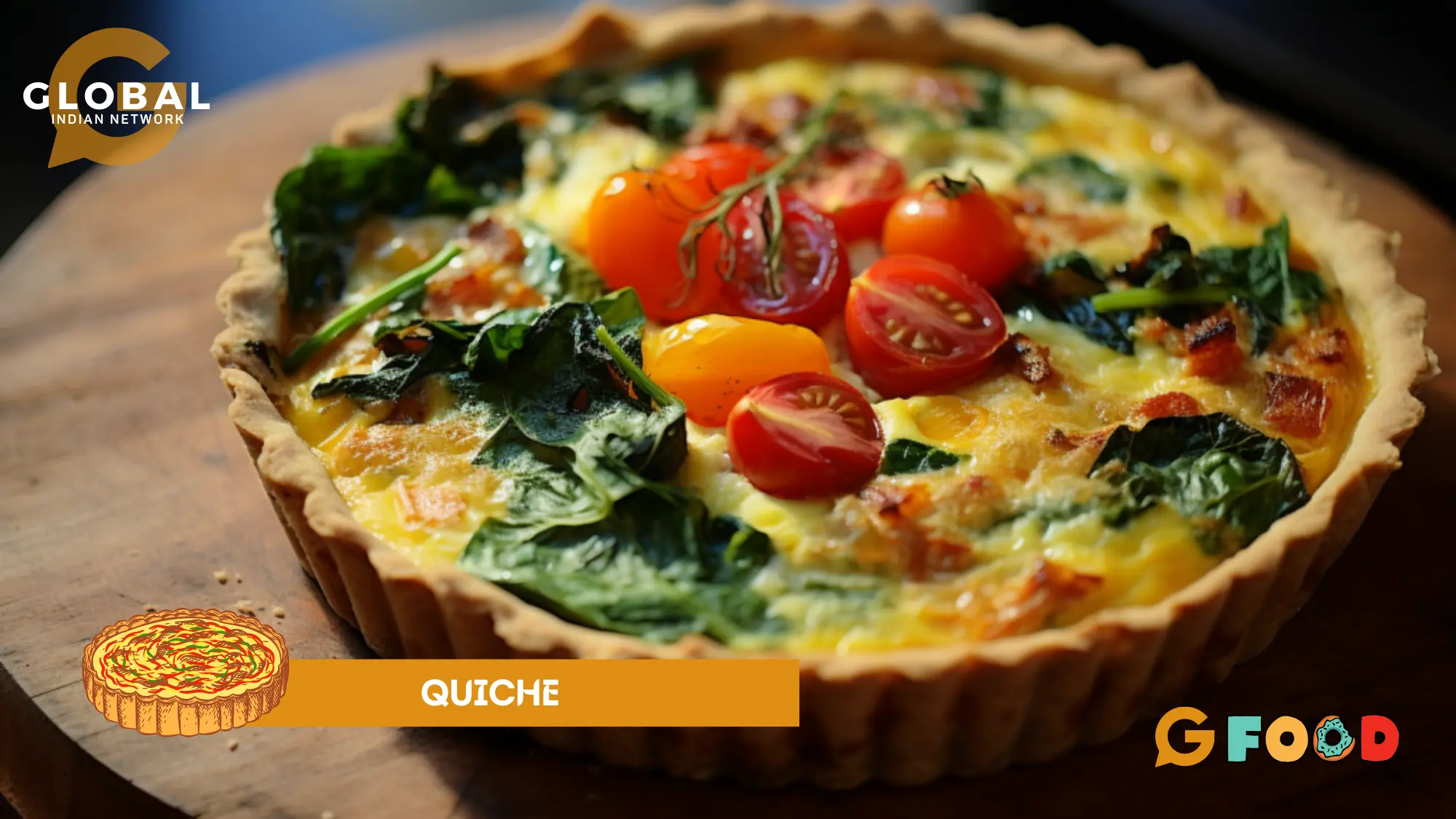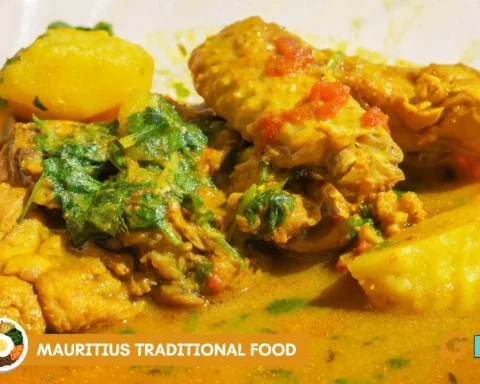How to make Quiche?- Introducing the culinary delight as charming as a sunrise picnic – Quiche! Bursting onto the scene with its French flair and versatile nature, Quiche has captured the hearts and palates of food enthusiasts worldwide. Imagine a golden, flaky crust cradling a velvety, eggy custard, harmoniously mingling with tantalizing fillings. It’s like a savoury symphony for your taste buds!
Moreover, this savoury marvel doesn’t shy away from accommodating diverse dietary preferences. Vegetarian? Load it up with garden-fresh veggies. Are you craving seafood? A seafood medley Quiche might be your next obsession. The options are as boundless as your imagination.
So, whether you’re seeking a culinary adventure as versatile as your mood or a dish that can instantly elevate any occasion, Quiche stands ready, a testament to the artistry of flavours and the joy of exploration. So dive into a slice of Quiche – it’s not just a dish; it’s an experience waiting to be savoured!
Table of Contents
What is Quiche?
A true masterpiece of culinary fusion, Quiche effortlessly merges elegance with comfort. From the classic Lorraine, with its sizzling bacon and creamy Gruyère, to the vibrant Mediterranean, adorned with sun-kissed tomatoes, feta, and spinach, Quiche boasts a personality as varied as the seasons. Brunches, picnics, or even a delightful weeknight dinner – Quiche fits right in, bringing its aura of sophistication and a dash of playfulness.
What is Quiche Made of?
Quiche is a delectable dish with a rich history and an even richer flavour profile. At its heart, Quiche comprises a few essential components, each contributing to its distinctive taste and texture.
- Crust: The foundation of Quiche is a buttery, flaky pie crust. This buttery crust, traditionally made with flour, butter, and sometimes a touch of Kosher salt, provides the perfect vessel for the Quiche’s other components.
- Eggs: The star of the show, the beaten egg mixture, forms the base of the Quiche filling. They create a luscious and creamy texture when baked.
- Cream: To enhance the custardy texture of the filling, heavy cream or a mixture of milk and cream is often added to the beaten eggs. This adds richness and a silky mouthfeel.
- Cheese: A generous amount of cheese is a must in Quiche. Varieties like Gruyère, cheddar, Swiss, or feta are commonly used to add depth and a delightful gooeyness.
- Fillings: The options here are virtually endless. Cooked meats like bacon, ham, or sausage lend their savoury notes. An assortment of veggies like fresh spinach, mushrooms, caramelized onions, and bell peppers provide colour, texture, and nutrients.
- Herbs and Spices: A sprinkle of fresh herbs like thyme, chives, or parsley, along with a pinch of salt, pepper, and perhaps a dash of nutmeg, adds complexity to the flavour.
- Onions: Often sautéed before being added to the filling, onions contribute sweetness and a subtle layer of flavour.
- Preparation: The fillings are combined with the egg-cream mixture, and the concoction is poured into the prepared crust. The ingredients mingle harmoniously as they bake.
- Baking: The Quiche is baked in the oven until the filling is set and the top turns light brown. The tantalizing aroma wafting from the oven signals its imminent deliciousness.
- Serving: Once cooled slightly, the Quiche is sliced into wedges or squares and served warm. It can take centre stage at breakfast, brunch, lunch, or even dinner.
How To Make Quiche?
Here’s a general step-by-step guide on how to make a basic Quiche:
Ingredients:
For the Crust:
- 1 ¼ cups all-purpose flour
- ½ teaspoon Kosher salt
- ½ cup cold unsalted butter, cut into small cubes
- 3-4 tablespoons ice water
For the Filling:
- 1 cup of your choice of fillings (cooked and diced green onions, cooked meat, goat cheese, etc.)
- 4 large eggs
- 1 cup milk or heavy cream (or a combination)
- Salt and pepper to taste
- Optional: herbs, spices, and seasonings of your choice
Instructions:
Prepare the crust: In a food processor, combine the flour and Kosher salt. Add the cold butter cubes and pulse until the mixture resembles coarse crumbs. Gradually add ice water, one tablespoon at a time, and pulse until the dough comes together. Turn the dough onto a floured surface, shape it into a disk, wrap it in plastic wrap, and refrigerate for at least 1 hour.
Preheat the Oven: Preheat your oven to 375°F (190°C).
Roll out the Crust: Roll out the chilled dough on a floured surface to fit your pie dish. Press the dough into the container and trim any excess dough hanging over the edges. Prick the bottom of the crust with a fork.
Par-Bake the Crust: Line the crust with parchment paper or foil. Fill it with pie weights or dry beans. Blind baking for about 15 minutes, then remove the weights and parchment and bake for an additional 5-7 minutes until the crust is lightly golden. Remove from the oven and cool it completely.
Prepare the Filling: Spread your choice of fillings evenly over the bottom of the par-baked refrigerated pie crust or frozen pie crust. It could be cooked and diced green onions, cooked meat, goat cheese, or a combination of these.
Make the Custard: Whisk the eggs and milk or heavy cream in a deep dish until well combined. Add a pinch teaspoon of Kosher salt and pepper and any optional herbs or spices you prefer.
Assemble and Bake: Pour the custard mixture over the fillings in the crust. The custard should evenly cover the filling.
Bake: Carefully transfer the Quiche to the preheated oven and bake for 30-35 minutes until the custard is set and the top is golden brown. The baking time may vary depending on your oven and the thickness of the Quiche.
Cool and Serve: Allow the Quiche to cool for a few minutes before slicing and serving. Quiche can be enjoyed warm or at room temperature.
Feel free to get creative with the fillings and seasonings you use in your Quiche. It’s a versatile dish that can be customised to your taste preferences and what you have on hand!
The Quiche Lorraine is a timeless classic that combines the smoky, salty goodness of bacon with the creaminess of eggs and cheese. Serve it up for breakfast, brunch, or any occasion that calls for a touch of elegance and comfort on a plate.
Classic Quiche Lorraine Recipe
Ingredients:
For the Crust:
- 1 ¼ cups all-purpose flour
- ½ teaspoon salt
- ½ cup cold unsalted butter, cut into small cubes
- 3-4 tablespoons ice water
For the Filling:
- 8 slices bacon, cooked and crumbled
- 1 ½ cups shredded Cheddar cheese (Gruyère is traditional)
- 4 large eggs
- 1 cup heavy cream
- ½ teaspoon salt
- ¼ teaspoon black pepper
- ¼ teaspoon ground nutmeg
Instructions:
Prepare the Crust: Combine flour and salt in a food processor. Add the cold butter cubes and pulse until the mixture resembles coarse crumbs. Gradually add ice water, one tablespoon at a time, and pulse until the dough comes together. Turn the dough onto a floured surface, shape it into a disk, wrap it in plastic wrap, and refrigerate for at least 1 hour.
Preheat the Oven: Preheat your oven temperature must be 375°F (190°C).
Roll out the Crust: Roll out the chilled dough on a floured surface to fit a 9-inch pie plate or baking sheet. Press the dough into the dish and trim any excess dough hanging over the edges. Prick the bottom of the crust with a fork.
Blind Bake the Crust: Line the crust with parchment paper or foil and fill it with pie weights or dried beans. Bake for about 15 minutes, then remove the weights and parchment and bake for an additional 5-7 minutes until the crust is lightly golden. Remove from the oven and let it cool slightly.
Prepare the Filling: Spread the cooked and crumbled bacon evenly over the bottom of the par-baked crust. Sprinkle the shredded Swiss cheese over the bacon.
Make the Custard: In a bowl, whisk together the eggs, heavy cream, or a cup of milk, salt, black pepper, and ground nutmeg until well combined.
Assemble and Bake: Pour the custard mixture over the bacon and Cheddar cheese in the crust. Carefully transfer the Quiche to the preheated oven and bake for 35-40 minutes, or on a stove with medium heat, until the custard is set to a savoury egg custard and the top is golden brown.
Cool and Serve: Allow the Quiche to cool for a few minutes before slicing and serving. Quiche Lorraine can be enjoyed warm or at room temperature. Place the Quiche with foil for reheating.
The Secret to Perfect Quiche Recipe
Remember, practice makes perfect! Each attempt helps you refine your technique and understand the nuances of your oven and ingredients. With these secrets in mind, you’re well on your way to crafting a flawless Quiche that’s a delight to the senses.
- Chilled Ingredients: Ensure your butter and liquids (water or cream) are cold. Cold butter helps create a flaky crust, and cold liquids prevent overworking the dough.
- Flaky Crust: For a flaky crust, handle the dough gently and avoid overmixing. A few visible butter pieces in the dough lead to those sought-after flaky layers.
- Par-Baking: Par-bake the crust for a short time before adding the filling to prevent it from becoming soggy.
- Prevent Sogginess: To further prevent sogginess, pre-cook or sauté moist fillings like vegetables and mushrooms to remove excess moisture before adding them to the crust.
- Balanced Custard: Create a balanced custard mixture with eggs and dairy (heavy cream, milk, or a combination). The ratio should be about 1 cup of dairy for every 4 large eggs.
- Seasoning: Season the custard well with salt, pepper, and optional herbs or spices. A touch of nutmeg adds depth and a hint of warmth.
- Optimal Filling Ratio: A good rule of thumb is to use about 1 to 1.5 cups of total fillings (cooked meat, vegetables, cheese) for a standard 9-inch pie dish.
- Even Distribution: Distribute fillings evenly across the crust to ensure every bite is flavorful.
- Layering: For Quiche with multiple fillings, layer ingredients like cheese and meat first, then pour the custard over them. This helps create a well-distributed, attractive appearance.
- Custard Set: Bake the Quiche until the custard is set or on a stove with medium heat, with a slight jiggle in the centre. Overbaking can result in a rubbery texture.
Conclusion
In a whirlwind of flavours and a symphony of textures, “How to Make Quiche” bids farewell with a playful wink. So there you have it, a slice of pure culinary magic that’s as versatile as your ever-changing cravings. From its flaky embrace to its custardy heart, Quiche is more than a dish – it’s an adventure!
So go ahead, and whip up a slice of joy that’s equally at home on brunch spreads, dinner tables, and cosy movie nights. With Quiche, you’re the maestro of taste, orchestrating a medley of ingredients that dance on your taste buds and bring a smile to your soul. Until next time, embrace the art of Quiche-making, and let your culinary creativity flourish!
FAQs
Why is it called Quiche?
“Quiche” originates from the German word “kuchen,” meaning cake. Over time, the term evolved as the dish transitioned from the savoury pie with an egg-based filling in Germany to the renowned French creation known as “Quiche,” which gained worldwide fame for its delectable combination of pastry, eggs, and various fillings.
Is Quiche an omelette?
Quiche and omelette share similarities in that both incorporate eggs but differ in their preparation and presentation. Quiche features a baked custard filling within a pastry crust, while an omelette is a dish of beaten eggs cooked quickly and folded around fillings on a stovetop.
Is Quiche Healthy?
Quiche can be made healthier by using whole-grain crusts, incorporating a variety of nutrient-rich vegetables, and opting for lean proteins. However, its nutritional value ultimately depends on the ingredients and portion sizes.
What is the difference between Quiche and Custard?
Quiche is a savoury dish consisting of a pastry crust filled with a mixture of eggs, cream, cheese, and various fillings like vegetables or meat. Custard, on the other hand, is a sweet or savoury dessert made from a mixture of eggs and milk or cream, often baked until set, and can be served on its own or as a component in various dishes.









